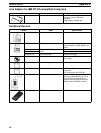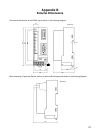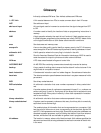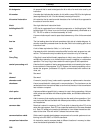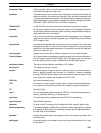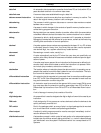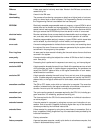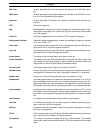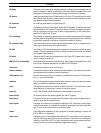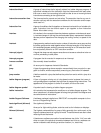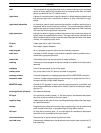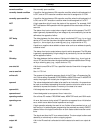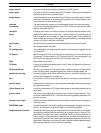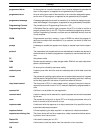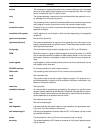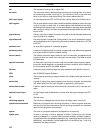
Glossary
105
I/O delay The delay in time from when a signal is sent to an output to when the status of the
output is actually in effect or the delay in time from when the status of an input
changes until the signal indicating the change in the status is received.
I/O device A device connected to the I/O terminals on I/O Units. I/O devices may be either
part of the Control System, if they function to help control other devices, or they
may be part of the controlled system.
I/O interrupt An interrupt generated by a signal from I/O.
I/O point The place at which an input signal enters the PC System, or at which an output
signal leaves the PC System. In physical terms, I/O points correspond to termi-
nals or connector pins on a Unit; in terms of programming, an I/O points corre-
spond to I/O bits in the IR area.
I/O refreshing The process of updating output status sent to external devices so that it agrees
with the status of output bits held in memory and of updating input bits in memory
so that they agree with the status of inputs from external devices.
I/O response time The time required for an output signal to be sent from the PC in response to an
input signal received from an external device.
I/O Unit The Units in a PC that are physically connected to I/O devices to input and output
signals. I/O Units include Input Units and Output Units, each of which is available
in a range of specifications.
I/O word A word in the IR area that is allocated to a Unit in the PC System and is used to
hold I/O status for that Unit.
IBM PC/AT or compatible A computer that has similar architecture to, that is logically compatible with, and
that can run software designed for an IBM PC/AT computer.
increment Increasing a numeric value, usually by 1.
indirect address An address whose contents indicates another address. The contents of the sec-
ond address will be used as the actual operand.
initialization error An error that occurs either in hardware or software during the PC System star-
tup, i.e., during initialization.
initialize Part of the startup process whereby some memory areas are cleared, system
setup is checked, and default values are set.
input The signal coming from an external device into the PC. The term input is often
used abstractly or collectively to refer to incoming signals.
input bit A bit in the IR area that is allocated to hold the status of an input.
input device An external device that sends signals into the PC System.
input point The point at which an input enters the PC System. Input points correspond phys-
ically to terminals or connector pins.
input signal A change in the status of a connection entering the PC. Generally an input signal
is said to exist when, for example, a connection point goes from low to high volt-
age or from a nonconductive to a conductive state.
install The preparation necessary to use a program or software package, such as the
LSS or SSS, on a computer.
instruction A direction given in the program that tells the PC of the action to be carried out,
and the data to be used in carrying out the action. Instructions can be used to
simply turn a bit ON or OFF, or they can perform much more complex actions,
such as converting and/or transferring large blocks of data.



